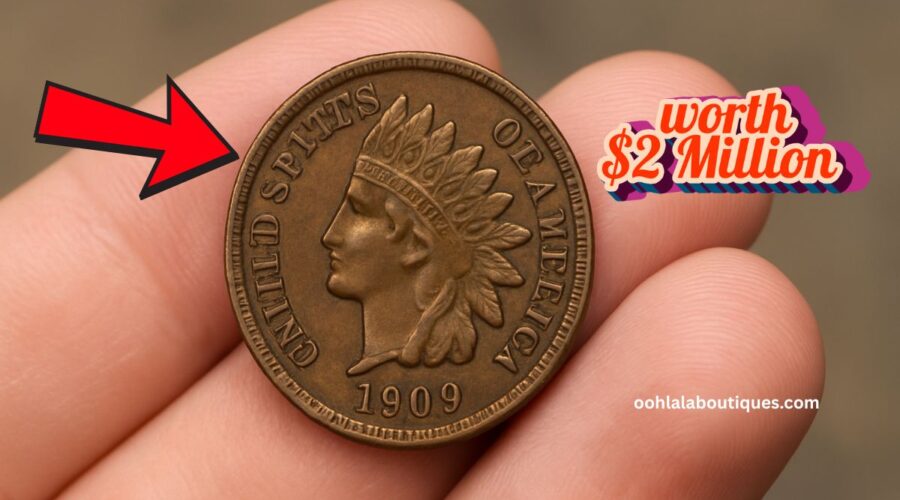7 Indian Head Pennies Worth Over $2 Million — Could One Be Hiding In Your Pocket?
Indian Head pennies—minted between 1859 and 1909—are among the most collectible and historically significant U.S. coins.
While many of these vintage pennies are common and sell for a few dollars, there are a select few Indian Head cents that are worth over $2 million each due to their rarity, minting errors, and pristine condition.
What makes these particular coins so valuable? Let’s dive into the details of the 7 Indian Head pennies that could be worth a fortune—and yes, a few of them have even shown up unexpectedly in pocket change.
Why Are Some Indian Head Pennies So Valuable?
The Indian Head penny series spans 50 years of U.S. minting history. Designed by James B. Longacre, these pennies originally featured a laurel wreath and later an oak wreath with a shield. Over the decades, certain factors have contributed to their rarity:
- Extremely low mintages in some years
- Minting errors and overdates
- Special proof strikes made for collectors
- Final-year issues from specific mints
- Surviving condition—especially uncirculated examples with red or red-brown luster
A combination of these factors has propelled select coins into the multi-million-dollar range.
7 Indian Head Pennies Worth Over $2 Million
| Coin | Why It’s Rare | Estimated Value |
|---|---|---|
| 1. 1859 Proof (First-Year) | First proof coin of the series, extremely limited | ~$2.2 million |
| 2. 1864 “L” on Ribbon | Designer’s initial added mid-year, rare color state | ~$2.1 million |
| 3. 1873 Doubled “LIBERTY” (Open 3) | Doubling error combined with scarce date style | Over $2 million |
| 4. 1877 Double‑Die Error | One of lowest mintage years, plus double-die strike | Over $2 million |
| 5. 1869/9 Overdate | Unique overdate with very few known specimens | Over $2 million |
| 6. 1909‑S (San Francisco Mint) | Final year + San Francisco mint + low mintage | Over $2 million |
| 7. Alternate 1859 Proof Variant | Alternate proof variant of series debut | ~$2.3 million |
Detailed Look at Each Million-Dollar Penny
1. 1859 Proof (First-Year)
The inaugural Indian Head cent was struck as a proof with highly polished dies for a very limited audience. In near-perfect condition, these proof coins command prices around $2.2 million at auction.
2. 1864 “L” on Ribbon
Midway through 1864, Chief Engraver James B. Longacre added his “L” initial to the ribbon on Liberty’s headdress. Combined with the highly desirable red-brown color state, pristine examples of this coin have reached ~$2.1 million in value.
3. 1873 Doubled “LIBERTY” (Open 3)
An error coin with a doubled inscription of “LIBERTY” and the open 3 version of the date makes this penny extremely rare. Mint-state examples are valued at well over $2 million.
4. 1877 Double-Die Error
The 1877 Indian Head penny is already one of the rarest due to an economic downturn that drastically limited production. Adding in a double-die strike, uncirculated examples now fetch well over $2 million.
5. 1869/9 Overdate
A fascinating overdate where one “9” was struck over another. Extremely rare, especially in high grades, and a top example has been valued above $2 million.
6. 1909‑S Indian Head Penny
The final year of the series was struck at the San Francisco Mint, producing only a small number of these coins. In top condition, these coins can command prices of over $2 million.
7. Alternate 1859 Proof Variant
An alternate version of the first-year proof Indian Head cent, with slightly different die markers, has sold for approximately $2.3 million, making it one of the most valuable in the series.
Could You Really Find One of These Pennies in Circulation?
Yes—while it is extremely unlikely, there are documented cases where valuable Indian Head pennies have turned up in everyday pocket change. One such example is an 1877 Indian Head penny spent unknowingly at a coffee shop.
Why do these coins still appear? Many have remained in family coin jars, desk drawers, and old piggy banks—sometimes overlooked for decades.
How to Spot a Million-Dollar Indian Head Penny
If you happen to come across an Indian Head penny, here’s what to do:
- Check the date carefully—look for the years listed above.
- Look for errors—doubling, overdates, or a mintmark (“S” on 1909 coins).
- Check condition—pristine, uncirculated “red” or “red-brown” pennies are worth far more.
- Do NOT clean the coin—cleaning drastically reduces value.
- Get it authenticated—submit the coin to a reputable grading service such as PCGS or NGC.
The dream of finding a multi-million-dollar Indian Head penny in your spare change is not entirely far-fetched. With only a few minutes of careful examination, you might uncover a true American treasure hiding right under your nose. Keep an eye on your penny jar—you never know when history might reveal itself!
FAQs
Are there really Indian Head pennies still in circulation?
While very rare, some Indian Head pennies—particularly worn common-date examples—still surface in change. However, the multi-million-dollar coins on this list are almost always held by collectors.
What condition must my Indian Head penny be in to be worth millions?
The highest-value coins are those that are either proof strikes or uncirculated examples in mint state (MS65 or higher). Lower-grade coins are still collectible but worth much less.
What’s the easiest way to tell if my Indian Head penny is valuable?
Start by checking the year and mintmark. Next, examine for errors like doubled dies or overdates. Finally, assess the coin’s color and wear—the less wear and more vibrant the color, the higher its potential value.


Leave a Reply